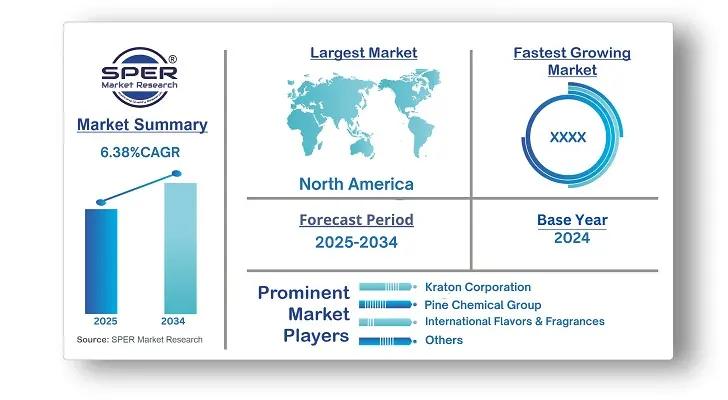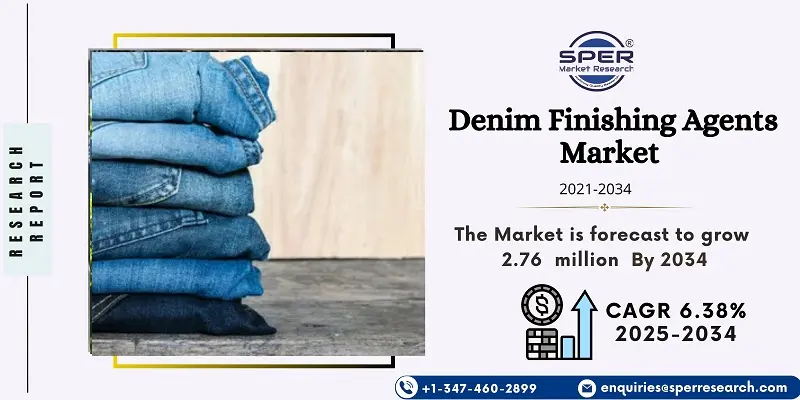Denim Finishing Agents Market Introduction and Overview
According to SPER Market Research, the Global Denim Finishing Agents Market is estimated to reach USD 2.76 billion by 2034 with a CAGR of 6.38%.
The report includes an in-depth analysis of the Global Denim Finishing Agents Market, including market size and trends, product mix, Applications, and supplier analysis. The growing use of specialized formulations in the production of denim items such as jeans, jackets, bags, trousers, and accessories has led to an increase in the production of finishing chemicals. With a rising demand for innovative finishes driven by a heightened sense of fashion among both youth and middle-aged consumers, global product consumption is expected to rise. However, The Denim Finishing Agents Market faces challenges such as the rising environmental concerns over chemical use and the need for compliance with strict regulations. Additionally, fluctuating raw material prices and the demand for sustainable solutions further complicate market growth.
By Product:
The market is segmented by type into softeners, enzymes, anti-back staining agents, bleaching agents, resins, neutralizing agents, dyes, detergents, and others. Softeners hold the largest market share and are expected to continue their growth in the coming years. These finishing agents are favored for their ability to improve the comfort, feel, and drape of denim fabrics. They provide a soft and smooth texture, making the fabric more wearable and attractive to consumers. Softeners also help reduce stiffness and enhance the flexibility of denim garments, improving their overall comfort and fit.
By Regional Insights
Asia Pacific has led the global denim finishing agents market, driven by significant consumption in emerging economies such as China, Bangladesh, India, and Vietnam. Over the past decade, the demand for these specialty products has surged, largely due to the region's growing manufacturing capabilities. Multinational companies are expanding their production facilities in Asian countries, attracted by lower labor costs, rapid economic growth, and favorable regulatory environments.
China’s denim industry is growing at a fast pace, prompting many major clothing retail brands to establish a presence in the country. The increasing demand for popular denim products and the rising disposable income among the middle and upper-middle class are key factors driving market changes
Competitive Landscape
The market is moderately consolidated. Some of the market key players are Les Dérivés Résiniques et Terpéniques-DRT, Ingevity, Kraton Corporation, ORGKHIM Biochemical Holding, Pine Chemical Group, International Flavors & Fragrances, Inc. (IFF)
Recent Developments:
In May 2023, CHT Group opened a new production facility in the Meghna Industrial Economic Zone (MIEZ) in Narayanganj, Bangladesh. As a subsidiary of CHT Group based in Tübingen, Germany, CHT Bangladesh is committed to producing high-quality products while prioritizing sustainability and safety.
In January 2023, Rodolf will begin building a new production facility in Bangladesh. This new plant is a strategic and essential move to enhance the company’s competitive standing both locally and globally.
Scope of the report:
| Report Metric | Details |
| Market size available for years | 2021-2034 |
| Base year considered | 2024 |
| Forecast period | 2025-2034 |
| Segments covered | By Product |
| Regions covered | North America, Latin America, Asia-Pacific, Europe, and Middle East & Africa |
| Companies Covered | North America, Latin America, Asia-Pacific, Europe, and Middle East & Africa
|
Key Topics Covered in the Report:
- Global Denim Finishing Agents Market Size (FY’2021-FY’2034)
- Overview of Global Denim Finishing Agents Market
- Segmentation of Global Denim Finishing Agents Market By Product (Enzymes, Resins, Softeners, Defoamers, Anti-rusting agents, Crush resistant, Anti-back staining agents, Others)
- Statistical Snap of Global Denim Finishing Agents Market
- Expansion Analysis of Global Denim Finishing Agents Market
- Problems and Obstacles in Global Denim Finishing Agents Market
- Competitive Landscape in the Global Denim Finishing Agents Market
- Details on Current Investment in Global Denim Finishing Agents Market
- Competitive Analysis of Global Denim Finishing Agents Market
- Prominent Players in the Global Denim Finishing Agents Market
- SWOT Analysis of Global Denim Finishing Agents Market
- Global Denim Finishing Agents Market Future Outlook and Projections (FY’2025-FY’2034)
- Recommendations from Analyst
1. Introduction
1.1. Scope of the report
1.2. Market segment analysis
2. Research Methodology
2.1. Research data source
2.1.1. Secondary Data
2.1.2. Primary Data
2.1.3. SPER’s internal database
2.1.4. Premium insight from KOL’s
2.2. Market size estimation
2.2.1. Top-down and Bottom-up approach
2.3. Data triangulation
3. Executive Summary
4. Market Dynamics
4.1. Driver, Restraint, Opportunity and Challenges analysis
4.1.1. Drivers
4.1.2. Restraints
4.1.3. Opportunities
4.1.4. Challenges
5. Market variable and outlook
5.1. SWOT Analysis
5.1.1. Strengths
5.1.2. Weaknesses
5.1.3. Opportunities
5.1.4. Threats
5.2. PESTEL Analysis
5.2.1. Political Landscape
5.2.2. Economic Landscape
5.2.3. Social Landscape
5.2.4. Technological Landscape
5.2.5. Environmental Landscape
5.2.6. Legal Landscape
5.3. PORTER’s Five Forces
5.3.1. Bargaining power of suppliers
5.3.2. Bargaining power of buyers
5.3.3. Threat of Substitute
5.3.4. Threat of new entrant
5.3.5. Competitive rivalry
5.4. Heat Map Analysis
6. Competitive Landscape
6.1. Global Denim Finishing Agents Market Manufacturing Base Distribution, Sales Area, Product Type
6.2. Mergers & Acquisitions, Partnerships, Product Launch, and Collaboration in Global Denim Finishing Agents Market
7. Global Denim Finishing Agents Market, By Product, (USD Million) 2021-2034
7.1. Enzymes
7.2. Resins
7.3. Softeners
7.4. Defoamers
7.5. Anti-rusting agents
7.6. Crush resistant
7.7. Anti-back staining agents
7.8. Others
8. Global Denim Finishing Agents Market, (USD Million) 2021-2034
8.1. Global Denim Finishing Agents Market Size and Market Share
9. Global Denim Finishing Agents Market, By Region, 2021-2034 (USD Million)
9.1. Asia-Pacific
9.1.1. Australia
9.1.2. China
9.1.3. India
9.1.4. Japan
9.1.5. South Korea
9.1.6. Rest of Asia-Pacific
9.2. Europe
9.2.1. France
9.2.2. Germany
9.2.3. Italy
9.2.4. Spain
9.2.5. United Kingdom
9.2.6. Rest of Europe
9.3. Middle East and Africa
9.3.1. Kingdom of Saudi Arabia
9.3.2. United Arab Emirates
9.3.3. Qatar
9.3.4. South Africa
9.3.5. Egypt
9.3.6. Morocco
9.3.7. Nigeria
9.3.8. Rest of Middle-East and Africa
9.4. North America
9.4.1. Canada
9.4.2. Mexico
9.4.3. United States
9.5. Latin America
9.5.1. Argentina
9.5.2. Brazil
9.5.3. Rest of Latin America
10. Company Profile
10.1. Ingevity
10.1.1. Company details
10.1.2. Financial outlook
10.1.3. Product summary
10.1.4. Recent developments
10.2. International Flavors & Fragrances, Inc. (IFF)
10.2.1. Company details
10.2.2. Financial outlook
10.2.3. Product summary
10.2.4. Recent developments
10.3. Kraton Corporation
10.3.1. Company details
10.3.2. Financial outlook
10.3.3. Product summary
10.3.4. Recent developments
10.4. Les Dérivés Résiniques et Terpéniques (DRT)
10.4.1. Company details
10.4.2. Financial outlook
10.4.3. Product summary
10.4.4. Recent developments
1.5. ORGKHIM Biochemical Holding
10.5.1. Company details
10.5.2. Financial outlook
10.5.3. Product summary
10.5.4. Recent developments
1.6. Pine Chemical Group
10.6.1. Company details
10.6.2. Financial outlook
10.6.3. Product summary
10.6.4. Recent developments
10.7. Others
11. Conclusion
12. List of Abbreviations
13. Reference Links
SPER Market Research’s methodology uses great emphasis on primary research to ensure that the market intelligence insights are up to date, reliable and accurate. Primary interviews are done with players involved in each phase of a supply chain to analyze the market forecasting. The secondary research method is used to help you fully understand how the future markets and the spending patterns look likes.
The report is based on in-depth qualitative and quantitative analysis of the Product Market. The quantitative analysis involves the application of various projection and sampling techniques. The qualitative analysis involves primary interviews, surveys, and vendor briefings. The data gathered as a result of these processes are validated through experts opinion. Our research methodology entails an ideal mixture of primary and secondary initiatives.





































